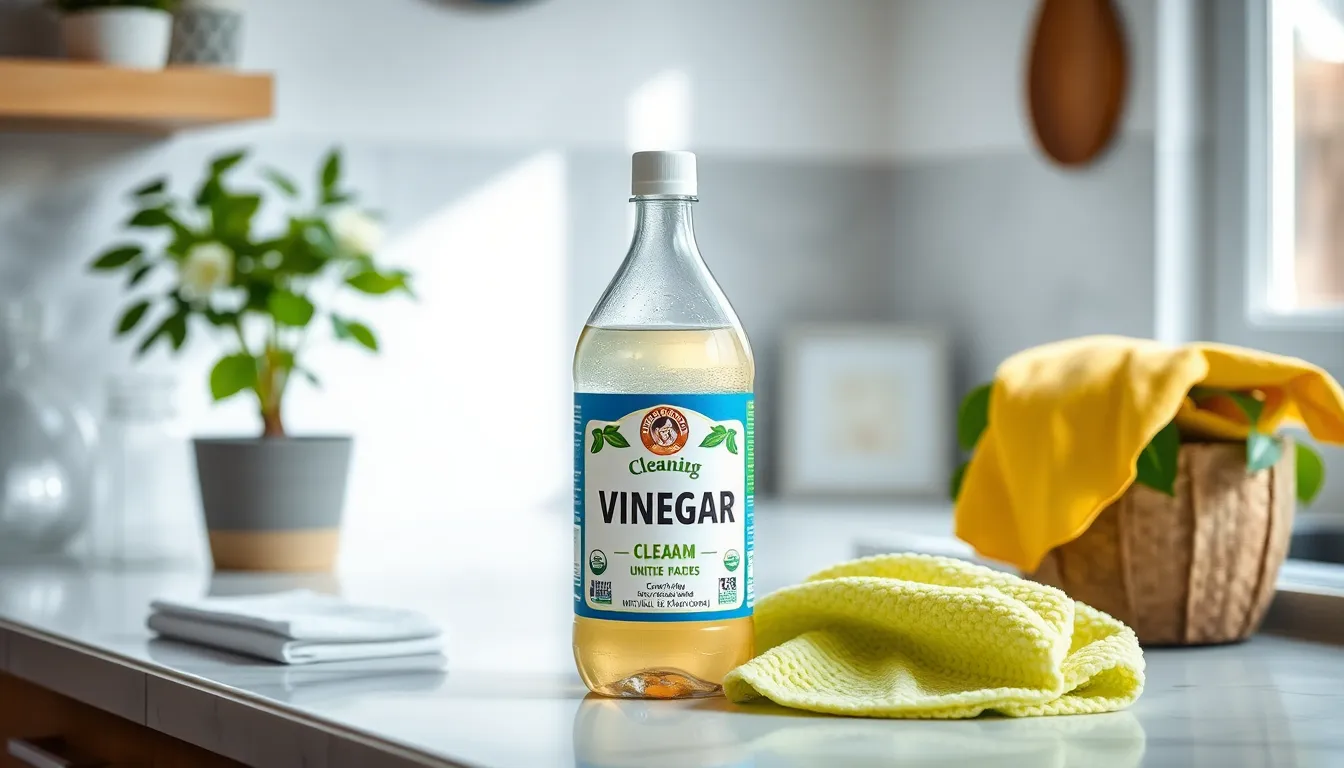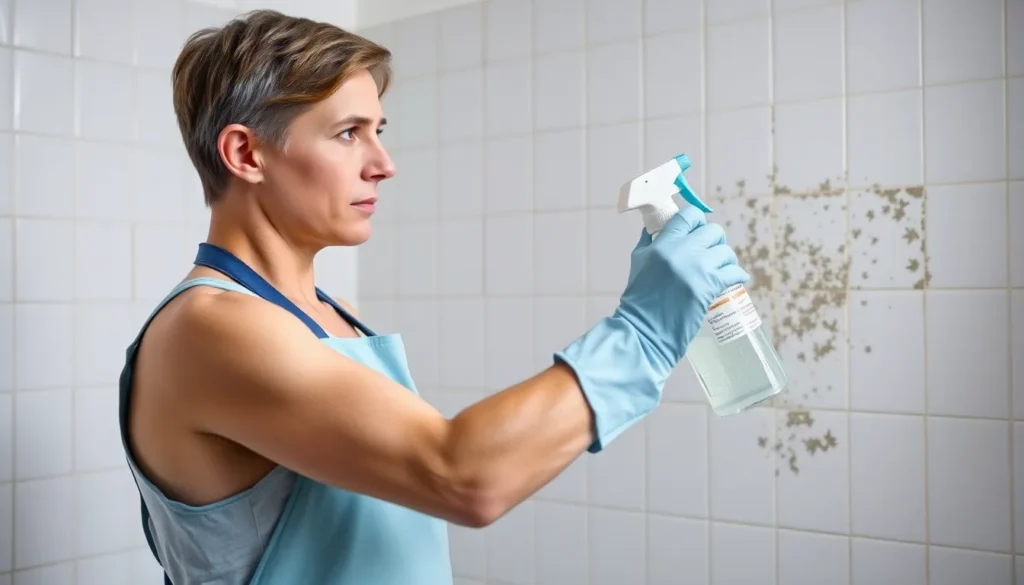Table of Contents
ToggleMold has a knack for showing up uninvited, turning cozy corners into fuzzy nightmares. If only it had a sense of humor! Fortunately, cleaning vinegar is here to save the day and kick mold to the curb. This everyday hero packs a punch with its natural acidity, making it a formidable foe against those pesky spores lurking in the shadows.
Overview of Cleaning Vinegar
Cleaning vinegar, a potent ally against mold, possesses a high acidity level of about 6%. This acidity enables it to effectively break down and eliminate mold spores. Preferred for its natural composition, cleaning vinegar stands out as a safer alternative to chemical cleaners. Many homeowners appreciate its environmentally friendly properties, making it a desirable choice for households.
Cleaning vinegar can be used on various surfaces, including tile, grout, and wood. When applied correctly, it helps inhibit future mold growth. Users often find that combining cleaning vinegar with water enhances its effectiveness. A common ratio involves mixing one part cleaning vinegar with one part water in a spray bottle.
Before applying cleaning vinegar, it’s essential to conduct a patch test on an inconspicuous area. This ensures that no damage occurs to the surface. For stubborn mold patches, applying full-strength cleaning vinegar directly to the affected area works well.
In terms of application, spray the solution on the moldy surface and let it sit for at least 30 minutes. Afterward, wipe the area clean with a cloth. Repeat the process if necessary to achieve optimal results.
Storing cleaning vinegar properly extends its shelf life. An airtight container kept in a cool, dark place maintains its potency. Regular use of cleaning vinegar as part of a cleaning routine reinforces its effectiveness against mold and keeps living spaces healthy.
Effectiveness of Cleaning Vinegar for Mold

Cleaning vinegar proves effective against mold due to its high acidity level. It targets mold spores directly, making it suitable for various surfaces.
Scientific Evidence
Research supports the efficiency of vinegar in eliminating mold. Studies indicate that vinegar achieves a 90% reduction in specific mold species. Its natural acetic acid disrupts mold cell membranes, thus preventing growth. The effectiveness of cleaning vinegar as a mold deterrent aligns with findings published in environmental microbiology journals. Laboratory tests verify its capability to inhibit mold reformation when used properly.
User Experiences
Users consistently report positive outcomes when applying cleaning vinegar against mold. Many indicate noticeable results after just one application, with reduced visible mold on surfaces. Testimonials frequently mention the pleasant smell and non-toxic nature of cleaning vinegar as significant advantages. Homeowners appreciate its affordability and ease of use, often sharing before-and-after photos that showcase successful mold removal. Repeat users specifically highlight consistent growth inhibition as a major benefit of this natural cleaner.
How to Use Cleaning Vinegar for Mold
Cleaning vinegar offers an effective approach to tackling mold with its natural properties. Utilizing proper techniques enhances its effectiveness in mold remediation.
Preparation Steps
Start by gathering necessary materials such as cleaning vinegar, water, a spray bottle, and cleaning cloths. Shake the cleaning vinegar to evenly distribute the acid before mixing it with water in a 1:1 ratio. Measure equal parts, ensuring that the solution is potent yet safe for various surfaces. Conduct a patch test on a small area to determine compatibility with the material. Gather all materials in one location to streamline the cleaning process.
Application Techniques
Spray the vinegar solution directly onto the affected moldy surface, covering it completely. Allow the mixture to sit for at least 30 minutes, allowing its natural acidity to penetrate the mold. Wipe the surface clean with a cloth, removing mold and residue. Rinse the area with water afterwards to eliminate any lingering vinegar scent. For persistent mold, repeat the application multiple times for optimal results. Regular application can prevent future mold regrowth, creating healthier living spaces.
Benefits of Using Cleaning Vinegar for Mold
Cleaning vinegar offers several advantages in mold removal due to its high acidity. This natural approach effectively disrupts mold cell membranes and inhibits further growth. Homeowners appreciate the affordability of cleaning vinegar compared to commercial products. They also enjoy the non-toxic nature, making it safer for families and pets.
Users report impressive results, often achieving a 90% reduction in specific mold species after treatment. Many individuals experience visible mold reduction after just one application. A pleasant smell follows the cleansing process, thanks to the natural ingredients present in the vinegar. Regular use provides ongoing protection against future mold growth.
Environmental benefits arise from choosing cleaning vinegar over chemical cleaners. Its biodegradable components lessen harmful impacts on the ecosystem. Easy application methods further enhance its appeal, allowing users to incorporate it easily into their cleaning routines.
Another notable benefit includes the versatility of cleaning vinegar across various surfaces. It safely tackles mold on tile, grout, and wood, adapting to different cleaning needs. Consistent use strengthens its effectiveness, fostering healthier living environments.
Users find cleaning vinegar straightforward to work with, requiring only a 1:1 ratio of cleaning vinegar to water. Preparing the solution is quick, and applying it to moldy areas becomes a simple task. Following a proper application process ensures optimal results, reinforcing the product’s benefits.
Cleaning vinegar serves as a powerful tool against mold. Its natural composition, effectiveness, and ease of use position it as a preferred option for maintaining clean, healthy spaces.
Precautions and Considerations
Cleaning vinegar provides an effective solution for mold removal, but its use requires specific precautions. Always test a small, inconspicuous area of the surface first to check for any adverse reactions. It’s important not to mix cleaning vinegar with bleach or other chemicals, as this can produce harmful fumes.
Ventilation plays a key role during the application process. Ensuring good airflow in the area can help mitigate any strong odors associated with vinegar. Additionally, individuals with respiratory conditions or sensitivities should consider wearing a mask to reduce inhalation of mold spores or strong vinegar vapors.
Children and pets need to stay away from treated areas until they are thoroughly ventilated and dried. Avoid direct skin contact with cleaning vinegar; wearing gloves can protect sensitive skin. Surfaces should be rinsed after application to eliminate any residual vinegar that may remain.
Regular inspections of mold-prone areas can help catch and address mold issues early. Scheduling these checks, especially in high humidity environments, reduces the likelihood of extensive mold growth. Users must engage in consistent cleaning practices to maintain mold-free spaces.
Finally, proper storage of cleaning vinegar is essential. Storing it in an airtight container keeps its potency intact. Keeping it in a cool, dark place prevents degradation and ensures effective use for future mold removal tasks.
Cleaning vinegar stands out as a powerful ally in the battle against mold. Its natural acidity not only eliminates mold spores but also helps prevent future growth, making it a practical choice for homeowners. With its non-toxic composition and affordability, cleaning vinegar offers a safe alternative to harsh chemical cleaners.
By incorporating cleaning vinegar into regular cleaning routines, individuals can maintain healthier living spaces. The ease of use and impressive results reported by users further solidify its status as an effective mold remediation solution. Embracing this eco-friendly option ensures a cleaner home environment while protecting families and pets from harmful substances.




